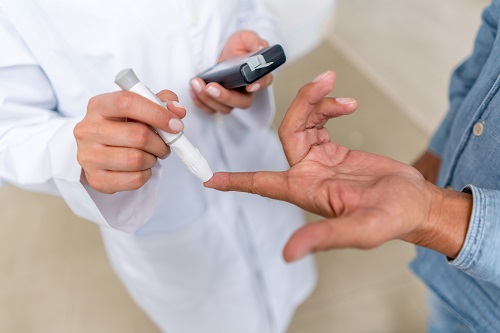Since forever it’s been recommended that those with type 2 diabetes (T2D) aim for an A1C target below 7 percent.
Hold onto your blood sugar meter! Long-term studies point to a need for higher numbers, says the American College of Physicians (ACP). The updated guideline supports an A1C target between 7 and 8 percent.1 5 This, ACP feels, is an easier-to-achieve blood sugar target than the previous lower treatment guide. In addition, a higher target may reduce certain medications’ side effects.
Several US health organizations, including the American Diabetes Association (ADA) and American Association of Clinical Endocrinologists (AACE), advise caution! Evidence suggests that an increase in normalized A1C scores may do more harm than good.1
Pros for Higher A1C Target
- Prolonged and/or intense use of certain drugs to control blood sugar levels may lead to hypoglycemia and weight gain among those diagnosed with T2D.2
- Studies suggest that certain management therapies used to achieve a 6.5 percent A1C target level may harm people with an advanced form of dementia, emphysema, and cancer.2
- Certain intensive treatment and management therapies to keep A1C levels within 5.7 and 6.4 percent may trigger cardiovascular issues and consequently increase mortality rates among those with T2D.3 4
- There is little substantial evidence to prove that the lower A1C target levels reduce risk of vision loss and impairment, end-stage renal disease, nephropathy, macro-vascular diseases, or even death.4
Cons for Higher A1C Target
- Most international and national health organizations prescribe A1C levels in the 5.7 to 6.4 percent range. An increase in the range will be inconsistent with practices adopted by most physicians.1
- According to the Diabetes Complications and Control Trial (DCCT), traditional A1C blood sugar levels help control the progression of eye disease by 76 percent, kidney disease by 50 percent, and nerve disease by 60 percent.1
- The DCCT follow up study reveals that those with T2D who reduced their A1C levels managed to decrease risk of cardiovascular disease by 42 percent and death from non-fatal heart attack risks, stroke, or death by 57 percent.1
- High blood sugar levels reported over a longer period of time are known to have a destructive impact on the functioning of vital body organs.1
- Reduced A1C levels may prevent the onset and progression of various micro-vascular surrogate events, such as retinopathy and kidney disorders.4
At this point, the pros and cons surrounding ACP’s new A1C target continue to fuel hot debates. One thing is for sure. Prescribing an A1C score between 7 and 8 percent demands further evaluation, careful research, and investigation before the medical community implements any proposed changes.
Resources
- American College of Physicians Recommending Controversial Increase in A1c of 7% to 8 percent https://www.diabetesincontrol.com/american-college-of-physicians-recommending-controversial-increase- in-a1c-of-7-to-8/
- Rethinking A1c goals for type 2 diabetes – Harvard Health Blog https://www.health.harvard.edu/blog/rethinking-a1c-goals-for-type-2-diabetes-2018032613452
- ACP recommends new ideal hemoglobin A1c range for type 2 diabetes https://www.mdedge.com/diabeteshub/article/160316/diabetes/acp-recommends-new-ideal-hemoglobin- a1c-range-type-2-diabetes
- ACP Guidance Statement on HbA | Annals of Internal Medicine | American College of Physicians https://annals.org/aim/fullarticle/2674121/hemoglobin-1c-targets-glycemic-control-pharmacologic-therapy- nonpregnant-adults-type
- A1C test – Mayo Clinic https://www.mayoclinic.org/tests-procedures/a1c-test/about/pac-20384643







